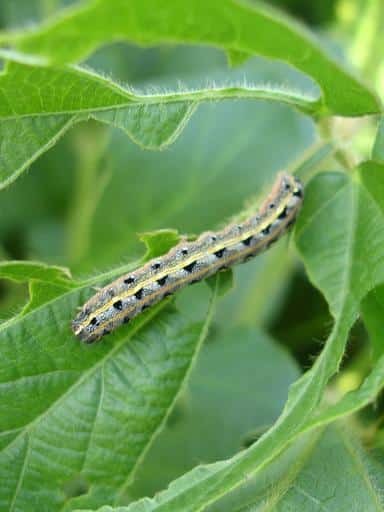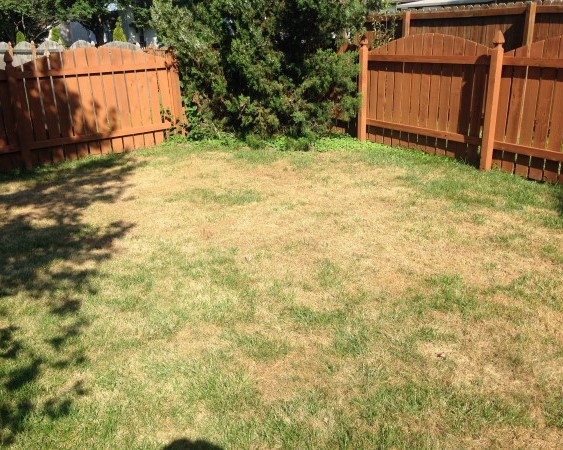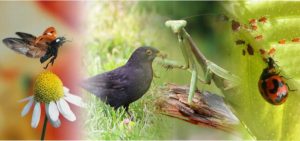When the fall season approaches, the temperatures are cool, and the days get shorter. Autumn is a wonderful time to enjoy time outside, especially in your backyard and other outdoor spaces.
The season can also be a time for fall pests that damage your landscaping, though. One alarming group of pests to worry about are fall armyworms. These insects are hungry and destructive, and their favorite food is turf grass.
That’s right: armyworms are eating your lawn.
Heavy infestations of these pests can decimate lawn grasses in just a few days, so we’re going to help you identify them, know how to spot signs of damage, and provide tips for how to control them before they eat everything in sight.
What Are Armyworms?


Armyworms, specifically fall armyworms, are a type of subtropical moth known as Spodoptera frugiperda. Annually, during midsummer, they migrate from the tropics to southern states like Georgia to lay their eggs. Their name comes from their uniform pattern of movement across lawns, and while they are called “worms,” they are caterpillars.
Life Cycle
These insects go through their life cycle in four stages: eggs, larvae, pupae, and adults. In the middle of summer, fall armyworms lay their eggs in many places. You may find armyworm eggs in shrubs, along posts and fences, or on the sides of buildings.
The next phase is the larval stage, and this is when armyworms are the most damaging. They are about 1-2 inches long and can be identified by their banded bodies and distinct upside-down “V” marks on their heads. Their diet consists of plant matter, making your lawn a significant part of their food resources.
Once armyworms are in their pupae stage, they are no longer damaging but can be unsightly. Once they emerge as adults, however, the life cycle will continue once more, making it important that you treat the problem before it starts again.
How to Identify
It’s best to keep an eye out for armyworms during the summer to early fall, which is when their development is most prominent. There are multiple signs that may show the presence of armyworms and a way to test for it. Here are just a few ways to find out:
Brown Patches
One significant sign of armyworms is discoloration in your yard. The caterpillars might cause brown patches to develop or create discolored portions, like how frost damages the grass. While many issues can cause grass discoloration, it’s good to check for armyworms when you first start to see this.
Birds
Insects are essential to a bird’s diet, and it’s no surprise that they will flock to an area with plenty of food. If you begin to notice a large number of birds starting to visit your yard, it may be a sign of armyworm populations in your area. While the birds may reduce the number of caterpillars, it’s still necessary to treat for them.
Abnormal Patterns
The first sign of army worm destruction often occurs at the tips of grass blades, giving them a transparent “windowpane” effect due to plant cells being eaten. Small brownish patches on your lawn, like we mentioned before, are another indication that you might have a problem. Armyworms are voracious eaters, but they’re also rather picky. They prefer to eat just the soft green layer of turf grass, and sometimes leave individual blades ragged and half-eaten. This leaves your lawn with a patchy appearance.
However, if army worms are present in sufficient numbers, the competition for food resources means they’ll be less choosy – and more destructive. A heavy infestation can lead to your grass being sheared to the ground, with nothing left but dirt and creeping runners. Healthy bermudagrass can typically recover from this type of defoliation, but newly-established ryegrass or fescue can be stunted or even killed outright.
Testing
While visible signs can be a good indicator of armyworms, a great way to test for them is through a soap flush test. This test is done by adding small amounts of dish soap to a large container of water and pouring it over a portion of your yard. If armyworms are present, the soap will irritate the caterpillars and encourage them to come to the surface. Once you see them, you can confirm that it’s time to treat the issue.
Conditions That Attract Armyworms
Fall armyworms regularly migrate to the area every year, but there are conditions they prefer when they settle into a yard. Here are a few factors they migrate towards when they are laying eggs:
Heavy Moisture
The summer season in George is often humid, making it an ideal habitat for young armyworms. Areas with heavy moisture help the larvae thrive, and if your yard has poor drainage or has gotten a significant amount of rainfall this year, it may be at risk of harboring the larvae.
Grass Types and Environment
Fall armyworms will eat a variety of grasses, but they especially love long grasses, such as bermudagrass, ryegrass, fescue and bluegrass. The tall grass blades provide better cover, and the larvae will quickly eat through it. They’re the most common cause of insect damage to golf courses, athletic fields, and home landscapes.
The presence of electrical lights around many of these settings draws the adult moths, and they tend to lay their greenish-white eggs on the undersides of leaves and various structures near the turf. This ensures the larvae have a plentiful food source after hatching, which is thoughtful of them as parents, but problematic for those of us who don’t want a decimated lawn.

Weeds and Debris
After a long summer, your yard can collect a heavy amount of plant debris, and the beginning of fall adds additional leaf debris. Collectively, it provides multiple habitats for armyworms. Debris helps to keep larvae hidden and safe from natural enemies like birds, spiders, and wasps.
How Do I Get Rid of Armyworms?
Now that you know what you’re dealing with, the most important question remains: how to get rid of them.
Once armyworms invade a yard, the damage can be devastating. If you want to reduce the damage done, or to prevent it before it begins, it’s necessary to take proper measures. There are several ways to take effective control over these insects, and these are a few of them:
Preventative Measures
An ounce of prevention is worth a pound of cure, so learning to identify armyworm eggs and treat them before they hatch is the ideal proposition. However, most of us lead busy lives, so skulking around the edges of the lawn checking out the undersides of leaves on bushes isn’t always practical or possible.
If you have discovered an active armyworm infestation, it’s important to treat it before it gets out of hand. Ensure that your lawn has proper drainage, and that any leaves or debris are cleared early on to avoid creating prime spots for eggs. If you are installing new sod for your yard or an outdoor space, check to make sure you are getting fresh and clean sod that is free of pests.
Insecticides and Treatments
Armyworms are crepuscular, which means they are most active in the early morning and late evening, although you can find them munching on your lawn at almost any point during the day. However, treatment is most effective during times of high activity, so it’s best to apply insecticide at dawn or dusk.
If armyworms have already begun to damage your lawn, you have to act quickly. For younger caterpillars, you may be able to use Bacillus thuringiensis. This is a more natural treatment that can be sprayed over your lawn to kill them. If they’re mature caterpillars, though, granules and spray insecticides are the most helpful. Be sure to cover your lawn thoroughly to reach all the larvae.
Premier Turf Care with Oasis
Maintaining your lawn near the end of summer can be exhausting, and with the risk of armyworms, you want your lawn to receive the best care it can get before any pest decides to eat it up.
If you’re still unsure what to look for, need recommendations for the most effective insecticide brands, or would rather have the services of a professional in addressing your armyworm problems, contact us for more information, or to schedule a service with us.








